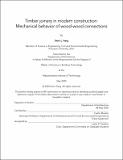| dc.contributor.advisor | Caitlin Mueller. | en_US |
| dc.contributor.author | Fang, Demi L. | en_US |
| dc.contributor.other | Massachusetts Institute of Technology. Department of Architecture. | en_US |
| dc.date.accessioned | 2020-10-08T21:27:58Z | |
| dc.date.available | 2020-10-08T21:27:58Z | |
| dc.date.copyright | 2020 | en_US |
| dc.date.issued | 2020 | en_US |
| dc.identifier.uri | https://hdl.handle.net/1721.1/127868 | |
| dc.description | Thesis: S.M. in Building Technology, Massachusetts Institute of Technology, Department of Architecture, May, 2020 | en_US |
| dc.description | Cataloged from the official PDF of thesis. | en_US |
| dc.description | Includes bibliographical references (pages [107]-112). | en_US |
| dc.description.abstract | Timber joinery is a method of geometrically interlocking timber elements prevalent in historic cultures around the world, including North America, Europe, and East Asia. The use of joinery as structural connections faded with the development of metallic screws and nails. Two recent developments offer the opportunity to revive this historic timber connection type: 1) the increasing desire to reduce embodied carbon in buildings by replacing more components with timber as a low-carbon structural material, and 2) recent digital fabrication capabilities which enable the precise milling of complex geometries as an alternative to the time- and labor-intensive handiwork required previously. How can joinery connections be designed in modern structural joints? Can we quantify the sustainability advantage of using these all-timber joints in lieu of the modern convention of metallic fasteners? This thesis addresses both questions as applied to the Japanese Nuki joinery type, though the workflows may be applied to any joinery geometry. First, the rotational stiffness of the Nuki joint is characterized and cross-verified using multiple methods. Second, the embodied carbon of a gravity frame using Nuki joints is compared to that of a gravity frame using conventional metallic fasteners. The use of Nuki joints not only eliminates the use of steel and aluminum but also provides rotational stiffnesses that enable smaller beam sections to be used. It is shown that gravity frames designed with Nuki joints could reduce embodied carbon by over 70% compared to gravity frames designed using conventional beam hanger connections. The findings make a case for all-timber joinery connections to be implemented as a sustainable alternative to conventional metallic connections used in modern timber construction. | en_US |
| dc.description.statementofresponsibility | by Demi L. Fang. | en_US |
| dc.format.extent | 144 pages | en_US |
| dc.language.iso | eng | en_US |
| dc.publisher | Massachusetts Institute of Technology | en_US |
| dc.rights | MIT theses may be protected by copyright. Please reuse MIT thesis content according to the MIT Libraries Permissions Policy, which is available through the URL provided. | en_US |
| dc.rights.uri | http://dspace.mit.edu/handle/1721.1/7582 | en_US |
| dc.subject | Architecture. | en_US |
| dc.title | Timber joinery in modern construction: Mechanical behavior of wood-wood connections | en_US |
| dc.type | Thesis | en_US |
| dc.description.degree | S.M. in Building Technology | en_US |
| dc.contributor.department | Massachusetts Institute of Technology. Department of Architecture | en_US |
| dc.identifier.oclc | 1196826370 | en_US |
| dc.description.collection | S.M.inBuildingTechnology Massachusetts Institute of Technology, Department of Architecture | en_US |
| dspace.imported | 2020-10-08T21:27:58Z | en_US |
| mit.thesis.degree | Master | en_US |
| mit.thesis.department | Arch | en_US |
